You are here
Tillya-Kari madrasah.
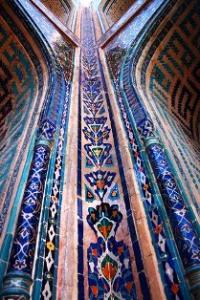
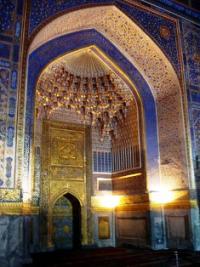
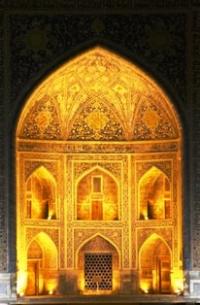
Cognitive tours over Samarkand.
“I've known rivers:
I've known rivers ancient as the world and older than the flow of human blood in human veins. My soul has grown deep like the rivers”
Langston Hughes.
Travel advice in Samarkand.
In 1647, ten years after completion of Sher-Dor madrasah, the construction of another madrasah - Tillya-Kari was started at the northern side of Registan, on the place of Mirzoi caravanserai.
By the mid-XVII century, Amir Temur's (Bibi-Khanym) cathedral mosque had already ruined and a new big mosque was required in the center of Samarkand, what caused the construction of Tillya-Kari.
Besides that, the madrasah of Alik Kukeltash had been also lost. Yalangtush-biy made a decision to construct a new complex on Registan, which should have combined a madrasah and cathedral mosque.
Construction of Tillya-Kari had taken almost twenty years and was completed five years after the of Yalangtush-biy, in 1660. Tilla Kari' means 'gilded', and though there is gilding on the madrasa's facade, it is nothing compared with the 1000 sq m of gold leaf used in the restoration of the 'Golden Mosque in 1979.
It left Geoffrey Moorhouse open-mouthed: 'Неге was а richness of colour greater than I had ever seen anywhere before, а splendor of red beyond the opulence of rubies and а royal blue of such intensity that it would have hurt the eyes if it had been unrelieved.
It was made perfect not only by the alliance with red, but by flashes of orange and dull gleaming of gold which punctuated it! The Soviet view was that the use of gold was decadent, а lazy way of surpassing the splendour achieved by superior craftsmanship in the Ulugbek madrasa.
But the craftsmanship in the Golden Mosque is not bad. Beneath the huge turquoise dome, for example, the ceiling appears domed; actually it is flat, and the trompe l’aeil effect is achieved by an extraordinarily intricate pattern of plant stems in gold leaf, which get smaller and smaller towards the centre.
The mosque was build along with the madrasa but was always а separate institution, build to succeed Bibi Khanym-which had already collapsed-as the city's main place of worship. Women were allowed in оп Fridays.
Now, just 14 years after being restored, all its decoration is threatened by rising groundwater resulting from cotton irrigation. А caravanserai was pulled down оn the north side of the square to make way for its biggest, newest, most extravagant building, the Tilla Kari madrasa (built 1646 - 1659).
Its 120 m-long facade is unusual in incorporating the outward-facing arched balconies of students cells. What sets it apart, though, is the mosque on the west side of the courtyard. The papier mache onto which much of the red and blue is painted is going soggy and peeling off, and restoration funds по longer flow from а Moscow which is now part of а foreign country and is anyway destitute.
For now, the substance of what Curzon called 'the noblest public square in the world remains intact, and it may still be true that 'no European spectacle indeed саn adequately be compared with it, in our inability to point to an open space in any western city that is commanded оn three of its four sides by Gothic cathedrals of the finest order.'
The big dome hall for the new cathedral mosque was built at the western side of the madrasah’s yard. Inside, opposite the entrance to the mosque there is mihrab, decorated with marble.
To the right there is minbar with high marble steps. The mosque is covered with rich carpet-like pattern from the floor up to the top. The ornament was done in a technique "kundal" with plenty of gold.
Therefore, the madrasah was called Tillya-Kari, i.e. “covered with gold” (or "gilt"). The scale of gilding on the dome, walls and mihrab of Tillya-Kari surpasses all famous architectural structures in Central Asia, what gives the evidence for intention to strike visitors by splandour and richness.
The yard was used for praying. Beside the mosque, there are galleries on columns. On perimeter were located hudjras for students: in two floors at the main façade and in one - at two others.
To get into the madrasah from the square of Registan was possible through three entrance doors. Unlike two other buildings on Registan, Tillya-Kari has no towers and corner minarets. Instead of them, there are low turrets with lanterns covered by blue domes.
By the XX century, facing of the madrasah had been largely lost. The blue dome of the mosque remained uncompleted and was finished just in the 1970s during restoration works. The gilded ornaments in the mosque were restored at the same time.
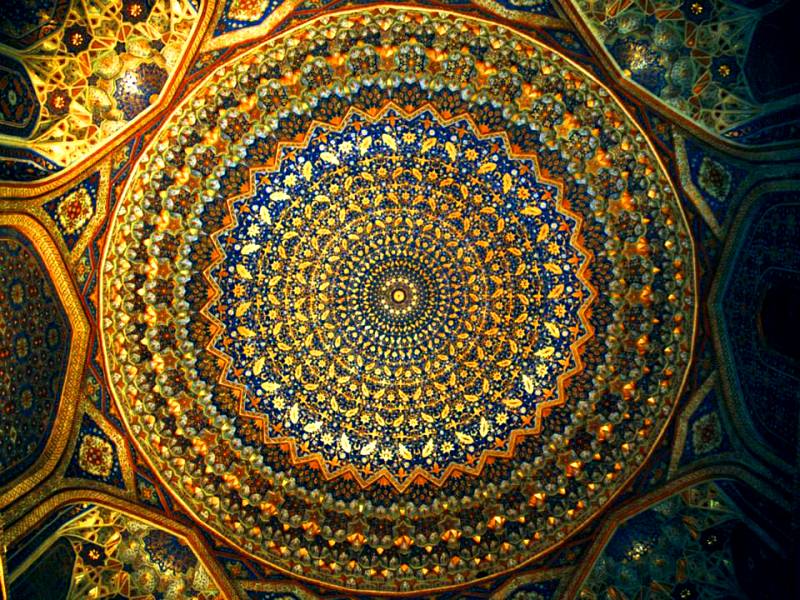
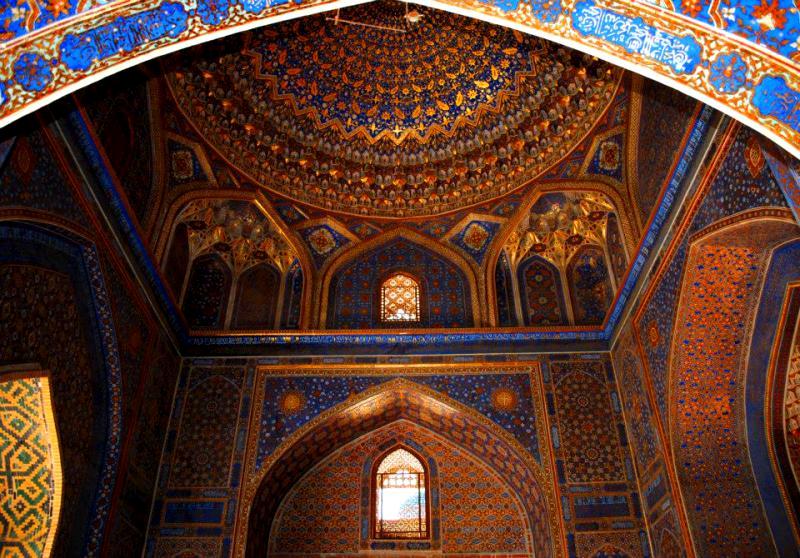
Authority:
Alexey Arapov. Samarkand. Masterpieces of Central Asia. Tashkent, San’at. 2004.
Photos
Alexander Petrov.







